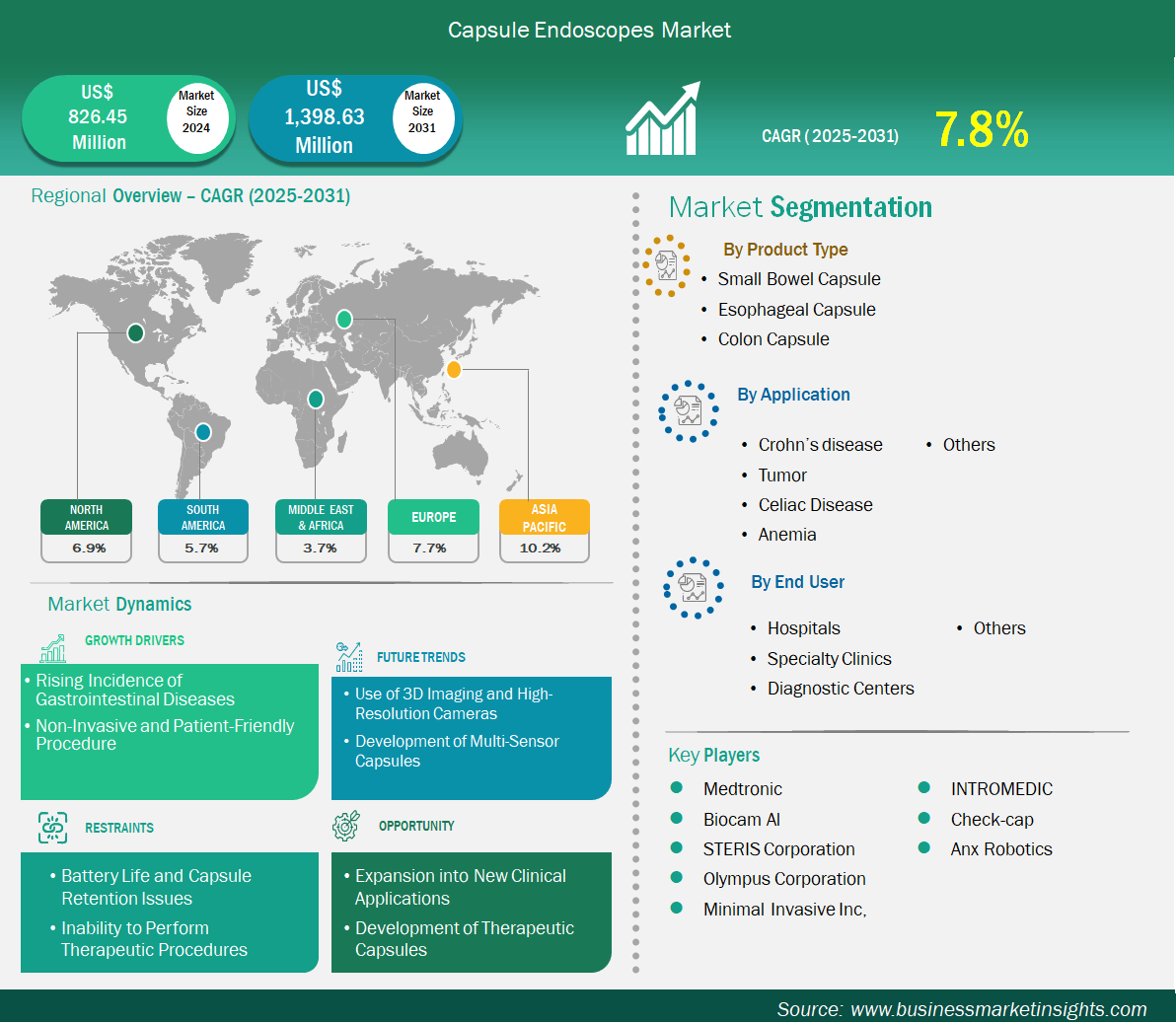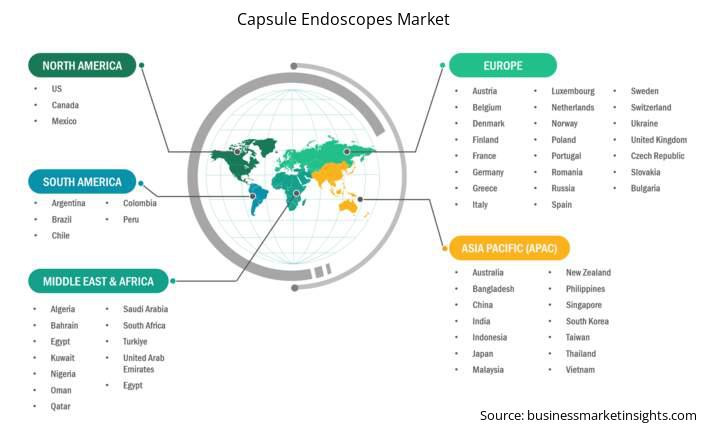Capsule Endoscopes Market Outlook (2021-2031)
No. of Pages: 200 | Report Code: BMIPUB00031682 | Category: Life Sciences
No. of Pages: 200 | Report Code: BMIPUB00031682 | Category: Life Sciences
The Capsule Endoscopes market size is expected to reach US$ 1,398.63 million by 2031 from US$ 826.45 million in 2024. The market is estimated to record a CAGR of 7.8% from 2025 to 2031.
The capsule endoscopes market is likely to grow as a non-invasive tool to check the gastrointestinal tract parts that regular endoscopes struggle to reach. Capsule endoscopy requires patients to swallow a tiny, pill-sized camera that takes pictures as it moves through the digestive system. This method helps to spot diseases such as Crohn's disease, GI bleeding, and small intestine tumors. The market expands due to more people knowing about less invasive tests, a rise in GI problems, and better technology for image quality and battery life.
In line with the adoption rate, the global capsule endoscopes market stood at US$ 826.45 million in 2024 and is expected to reach US$ 1,398.63 million by 2031. Also, better healthcare systems and more use in new markets make it easier to get. But capsule endoscopes can't do treatments and cost a lot, which limits their use. Even with these problems’ new ideas like AI and remote checking offer big chances making capsule endoscopy a hopeful area in digestive health testing.
Capsule Endoscopes Market Strategic Insights

Capsule Endoscopes Market Segmentation Analysis
Key segments that contributed to the derivation of the capsule endoscopes market analysis are product type, application, and end user.
Rising number of people suffering from chronic gastrointestinal diseases such as gastric cancer, IBD and others are major driving factor for this market. Doctors need to examine the entire gastrointestinal tract, including hard-to-reach spots like the small intestine, to diagnose conditions such as Crohn's disease, small bowel tumors, unexplained gastrointestinal bleeding, and celiac disease. Regular endoscopy often can't reach these areas well. Capsule endoscopy gives doctors a non-invasive way to get clear pictures throughout the digestive system helping them to spot and manage these diseases earlier. More people are getting these tests because of the worldwide increase in lifestyle-related health issues aging populations, and better understanding of these diseases. As more patients get regular check-ups and monitoring for gastrointestinal problems, they need more advanced capsule endoscopy systems. This trend pushes healthcare providers to use new technologies that give more accurate diagnoses, which helps the market grow across the globe.
Capsule endoscopy is becoming more popular as it gives patients a non-invasive option instead of regular endoscopic procedures. Unlike normal endoscopy where doctors put a tube through your mouth or bottom and often need to sedate you capsule endoscopy just needs you to swallow a tiny camera shaped like a pill. This makes it painless, easy, and handy so patients like it more and feel more at ease. It doesn't need anesthesia or hospital stays, which cuts down on risks, time, and medical costs. Because it's so simple to use more outpatient clinics can offer it making it easier to get for older folks or high-risk patients who can't handle invasive procedures. The better experience for patients and safer nature of capsule endoscopy push its use making it a good choice for both doctors and patients to diagnose gut problems.
By product type, the capsule endoscopes market is segmented into small bowel capsule, esophageal capsule and colon capsule. The small bowel capsule segment dominated the market in 2024. The small bowel capsule is most used because it effectively visualizes the entire small intestine, an area difficult to access with traditional endoscopes, aiding in comprehensive diagnosis and monitoring.
By application, the capsule endoscopes market is segmented into Crohn's disease, tumor, celiac disease, anemia and others. The Crohn's disease segment dominated the market in 2024. Crohn’s disease drives capsule endoscope use as it requires detailed imaging of the small intestine to detect inflammation and ulcers, helping in early diagnosis and effective disease management.
By end user, the market is segmented into hospitals, specialty clinics, diagnostic centers and others. The hospitals segment held the largest share of the market in 2024. Hospitals are the primary users due to their advanced diagnostic facilities and specialist expertise, enabling wide adoption of capsule endoscopy for complex gastrointestinal evaluations and patient monitoring.
Capsule Endoscopes Market Report Highlights
Report Attribute
Details
Market size in 2024
US$ 826.45 Million
Market Size by 2031
US$ 1,398.63 Million
Global CAGR (2025 - 2031) 7.8%
Historical Data
2021-2023
Forecast period
2025-2031
Segments Covered
By Product Type
By Application
By End User
Regions and Countries Covered
North America
Europe
Asia-Pacific
South and Central America
Middle East and Africa
Market leaders and key company profiles
The "Capsule Endoscopes Market Size and Forecast (2021–2031)" report provides a detailed analysis of the market covering below areas:

The geographical scope of the capsule endoscopes market report is divided into five regions: North America, Asia Pacific, Europe, Middle East & Africa, and South & Central America. The capsule endoscopes market in Asia Pacific is expected to grow significantly during the forecast period.
The Asia Pacific capsule endoscopes market is segmented into China, Japan, South Korea, India, Australia, New Zealand, Indonesia, Malaysia, Philippines, Singapore, Thailand, Vietnam, Taiwan, Bangladesh and Rest of Asia. The Asia Pacific capsule endoscopes market is growing rapidly due to rising gastrointestinal disease prevalence and increasing awareness about minimally invasive diagnostic options. Healthcare infrastructure is being developed and investments are being made in state-of-the-art medical technologies in countries like China, India, Japan, and South Korea that enable patients to have greater access to capsule endoscopy. The demand is also driven by the large population base, along with an increase in cases of Crohn's disease, gastrointestinal bleeding, and small intestine cancers. Government initiatives pushing for early diagnosis and cancer screening programs support market growth. The rising trend among patients toward non-invasive procedures, as well as technological augmentation in capsule endoscopy- enhanced image resolution and longer battery life are among them-too leads to increased adoption. But the main hurdle is the high cost and non-uniform price availability in every nook and corner. All in all, the Asia Pacific promises a massive scope of growth for capsule endoscope manufacturers, courtesy of rising healthcare expenditure and wider diagnostic outpatient services.
The capsule endoscopes market is evaluated by gathering qualitative and quantitative data post primary and secondary research, which includes important corporate publications, association data, and databases. A few of the key developments in the capsule endoscopes market are:
The Capsule Endoscopes Market is valued at US$ 826.45 Million in 2024, it is projected to reach US$ 1,398.63 Million by 2031.
As per our report Capsule Endoscopes Market, the market size is valued at US$ 826.45 Million in 2024, projecting it to reach US$ 1,398.63 Million by 2031. This translates to a CAGR of approximately 7.8% during the forecast period.
The Capsule Endoscopes Market report typically cover these key segments-
The historic period, base year, and forecast period can vary slightly depending on the specific market research report. However, for the Capsule Endoscopes Market report:
The Capsule Endoscopes Market is populated by several key players, each contributing to its growth and innovation. Some of the major players include:
The Capsule Endoscopes Market report is valuable for diverse stakeholders, including:
Essentially, anyone involved in or considering involvement in the Capsule Endoscopes Market value chain can benefit from the information contained in a comprehensive market report.